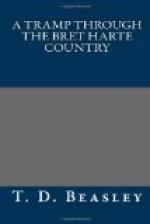A sturdy tramp walking in the middle of the road, who had witnessed the scene, shouted as he passed: “Why didn’t yer ride wid de guy?” I replied as before, “Because I prefer to walk;” adding for his benefit, “I’ve no use for autos.” Whereupon he threw back his head and burst into peal after peal of such hearty laughter that, from pure contagion, I perforce joined in the chorus. In the days of Fielding and Sam Johnson, this fellow would have been dubbed “a lusty vagabond;” in the slangy parlance of today, he was a “husky hobo,” equipped as such, even to the tin can of the comic journals. To him, the humor of a brother tramp refusing a ride — in an autocar, at that — appealed with irresistible force.
To walk in the middle of the road is characteristic of the genuine tramp. There must be some occult reason for this peculiarity, since in a general way, it is far easier going on the margin. Perhaps it is because he commands a better view of either side, with a regard to the possible onslaught of dogs. There is something about a man with a pack on his back that infuriates the average dog, as I have on several occasions found to my annoyance. Robert Louis Stevenson, in his whimsical and altogether delightful “Travels with a Donkey,” thus vents his opinion anent the dog question:
“I was much disturbed by the barking of a dog, an animal that I fear more than any wolf. A dog is vastly braver and is, besides, supported by a sense of duty. If you kill a wolf you meet with encouragement and praise, but if you kill a dog, the sacred rights of property and the domestic affections come clamoring around you for redress. At the end of a fagging day, the sharp, cruel note of a dog’s bark is in itself a keen annoyance; and to a tramp like myself, he represents the sedentary and respectable world in its most hostile form. There is something of the clergyman or the lawyer about this engaging animal; and if he were not amenable to stones, the boldest man would shrink from traveling a-foot. I respect dogs much in the domestic circle; but on the highway or sleeping afield, I both detest and fear them.”
I confess to a feeling of sympathy with the men we so indiscriminately brand with the contemptuous epithet, “hobo.” In the first place, the road itself, with its accompanying humors and adventures, forms a mutual and efficacious bond. How little we know of the “Knights of the Road,” or the compelling circumstances that turned them adrift upon the world! “All sorts and conditions of men” are represented, from the college professor to the ex-pugilist. I have “hit the ties” in company with a so-called “hobo” who quoted Milton and Shakespeare by the yard, interspersed with exclamations appreciative of his enjoyment of the country through which we were passing. And once when on a tramp along the coast from San Francisco to Monterey, I fell in at Point San Pedro with a professional, who bitterly regretted the coming of the Ocean Shore Railway, then in process of construction. “For years,” said he, “I have been in the habit of making this trip at regular intervals, on my way south. I had the road to myself and thoroughly enjoyed the peaceful beauty of the scene; but now this railroad has come with its mushroom towns, and all the charm has gone. Never again for me! This is my last trip!”




